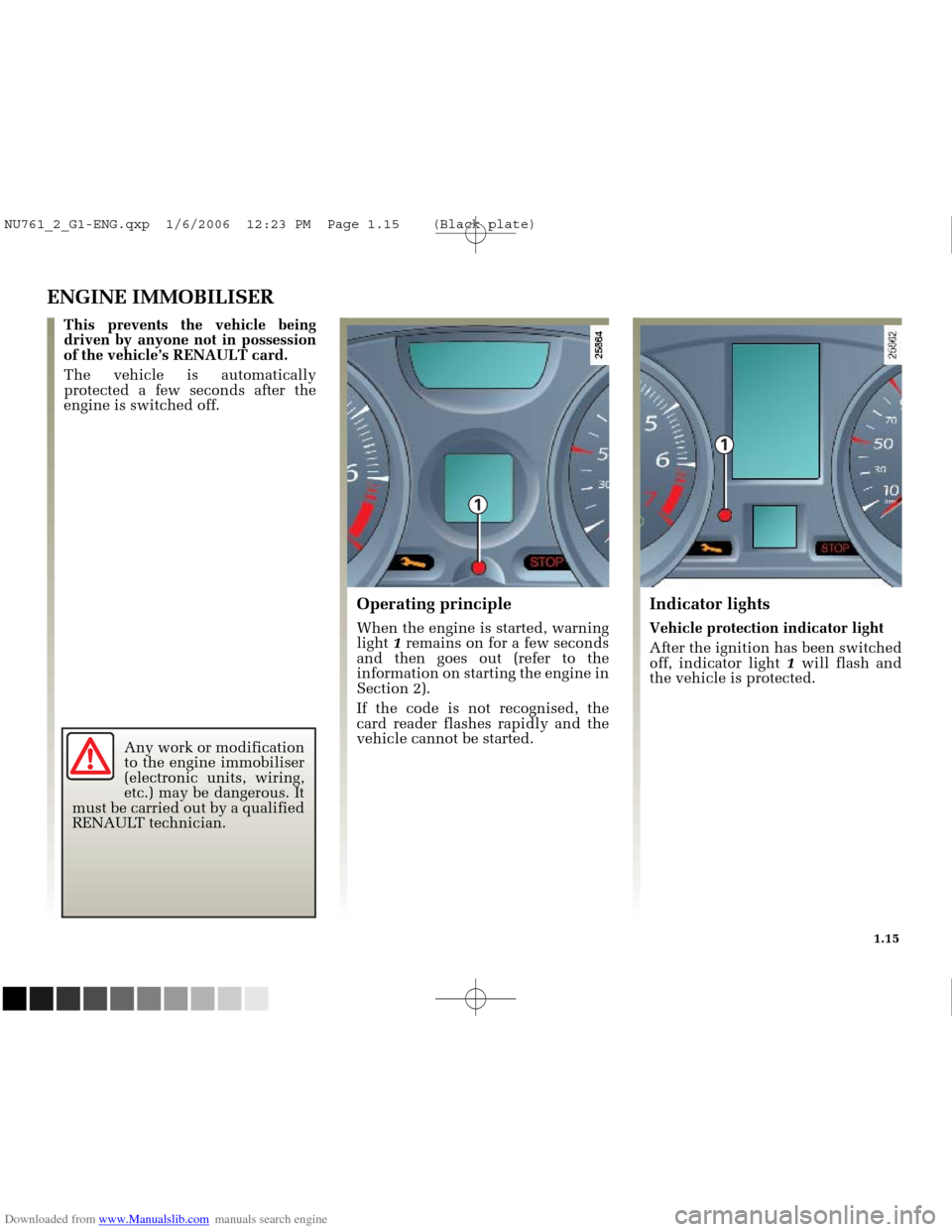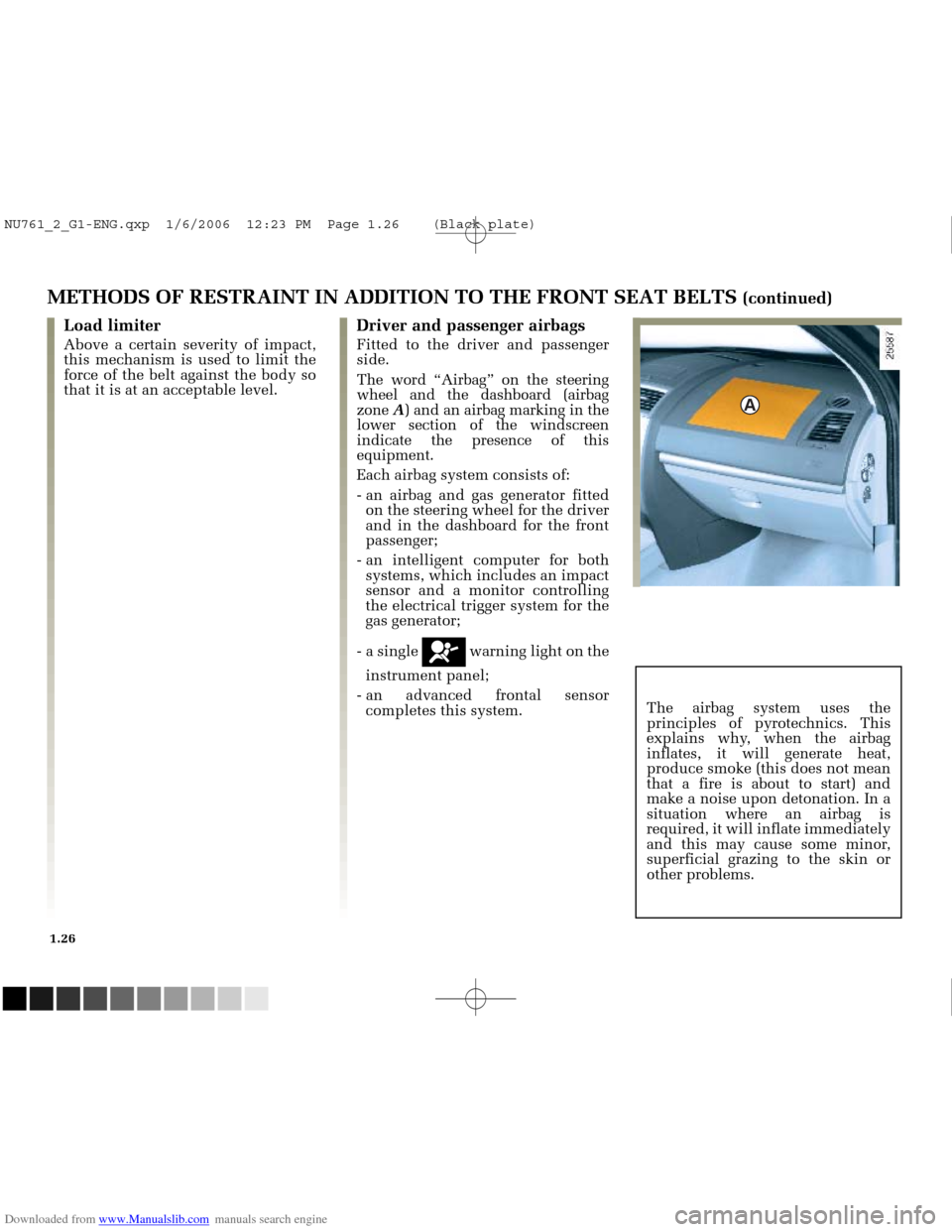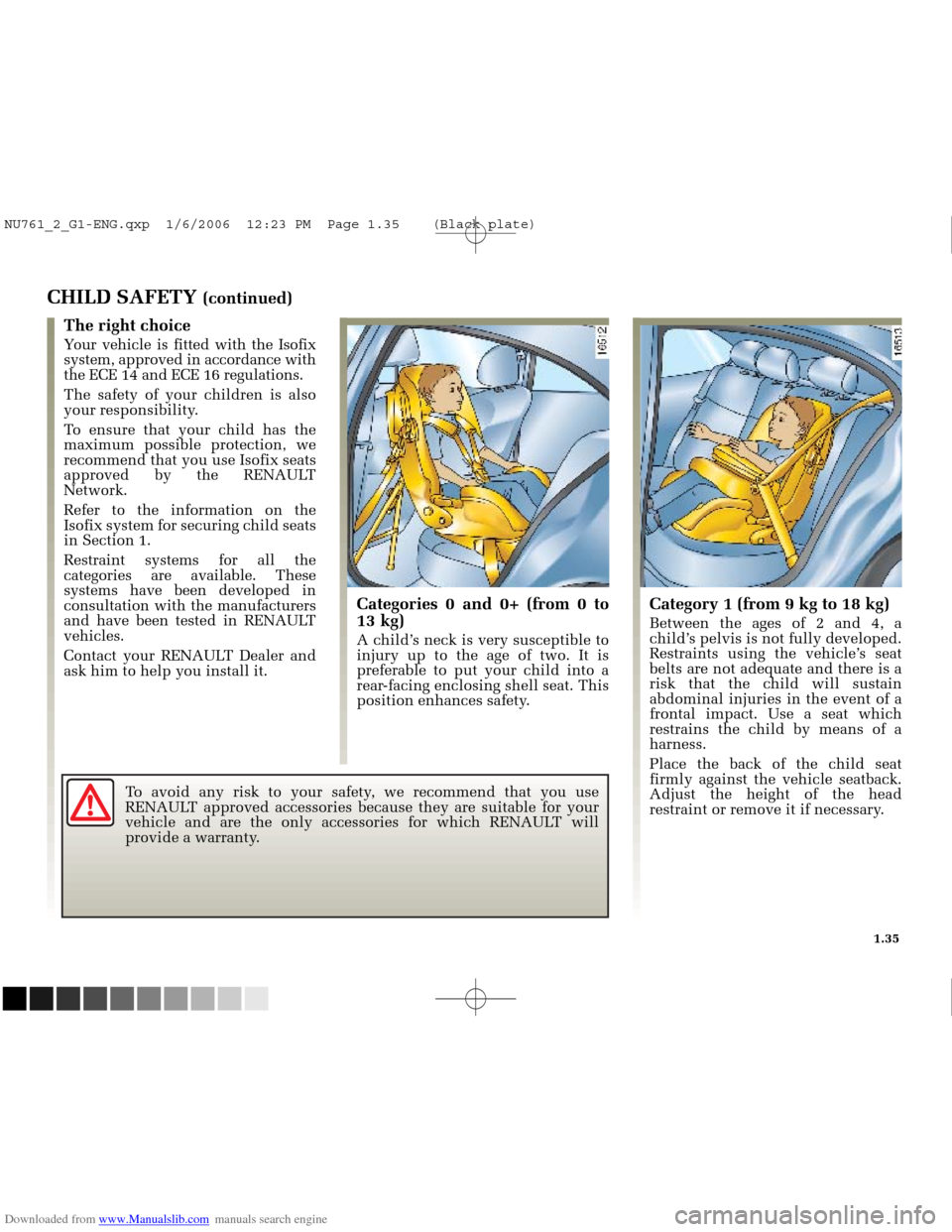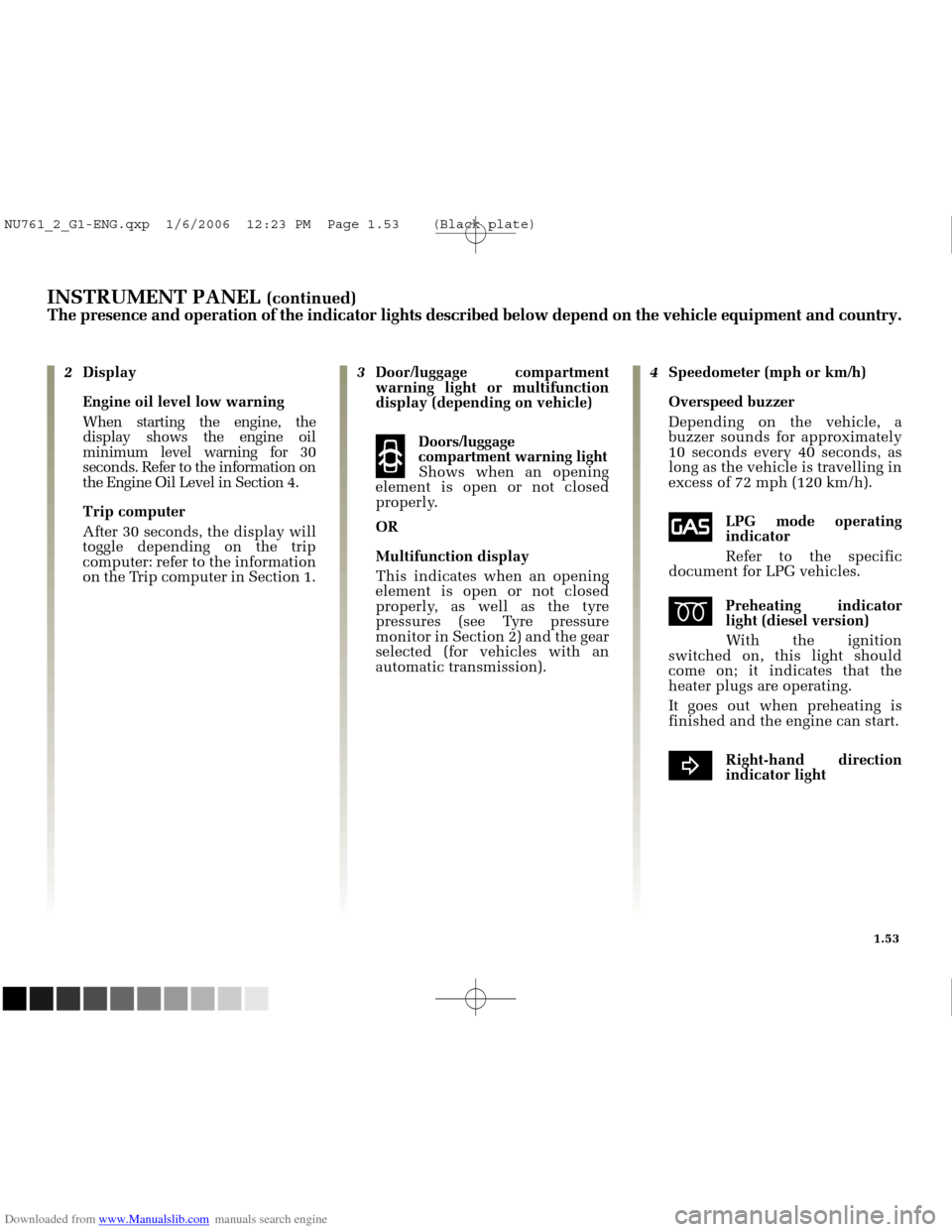section 1 RENAULT MEGANE 2005 X84 / 2.G User Guide
[x] Cancel search | Manufacturer: RENAULT, Model Year: 2005, Model line: MEGANE, Model: RENAULT MEGANE 2005 X84 / 2.GPages: 250, PDF Size: 5.72 MB
Page 21 of 250

Downloaded from www.Manualslib.com manuals search engine
A
2
1
NU761_2_G1-FRA.qxd 10/11/05 15:53 Page 1.11
1.11
LOCKING/UNLOCKING THE DOORS
Locking/unlocking the doors
from the outside
This is done using the RENAULT
card; see RENAULT card in Section 1.
In certain cases, the RENAULT card
may not work:
- if the vehicle is located in a zone of high electromagnetic radiation,
- if appliances operating on the same frequency as the card (mobile
phone, etc.) are used;
- drain on the RENAULT Card battery, flat battery, etc.
It is then possible:
- to use the emergency key (depending on vehicle, either built
into the card or separate) for the
front left-hand door;
- to manually lock each of the doors (see the following page);
- to use the door locking and unlocking control inside the vehicle
(refer to the information on Locking
and unlocking from the inside in
Section 1).
Using emergency key 2built
into the RENAULT card
Remove cover Afrom the front left-
hand door (using the tip of the
emergency key) in notch 1.
Move it upwards to remove cover A. Insert key
2into the lock of the front
left-hand door and lock or unlock.
NU761_2_G1-ENG.qxp 1/6/2006 12:23 PM Page 1.11 (Black plate)
Page 25 of 250

Downloaded from www.Manualslib.com manuals search engine
1
1
NU761_2_G1-FRA.qxd 10/11/05 15:53 Page 1.15
1.15
Any work or modification
to the engine immobiliser
(electronic units, wiring,
etc.) may be dangerous. It
must be carried out by a qualified
RENAULT technician.
ENGINE IMMOBILISER
This prevents the vehicle being
driven by anyone not in possession
of the vehicle’s RENAULT card.
The vehicle is automatically
protected a few seconds after the
engine is switched off.
Operating principle
When the engine is started, warning
light 1remains on for a few seconds
and then goes out (refer to the
information on starting the engine in
Section 2).
If the code is not recognised, the
card reader flashes rapidly and the
vehicle cannot be started.
Indicator lights
Vehicle protection indicator light
After the ignition has been switched
off, indicator light 1will flash and
the vehicle is protected.
NU761_2_G1-ENG.qxp 1/6/2006 12:23 PM Page 1.15 (Black plate)
Page 27 of 250

Downloaded from www.Manualslib.com manuals search engine
A
2
1
NU761_2_G1-FRA.qxd 10/11/05 15:53 Page 1.17
1.17
The head restraint is
important for safety. Ensure
that it is in place and in the
correct position. The
distance between your head and
the head restraint should be as
small as possible. The top of your
head should be in line with the top
of the head restraint.
FRONT HEAD RESTRAINTS
To remove the head restraint
Press button 2and lift the head
restraint until it comes free.
To refit the head restraint
Insert the head restraint rods into
the holes, with the notches facing
forwards.
Move tab 1 forwards and lower the
head restraint to the required height.Head restraints with a tab 1:
To adjust the headrest
Slide it upwards to the required
height.
To lower the headrest
Move tab 1 forwards and lower the
head restraint to the required height.
To adjust the angle of the headrest
Depending on the vehicle, move
section Aof the headrest forwards or
backwards until it feels comfortable.
NU761_2_G1-ENG.qxp 1/6/2006 12:23 PM Page 1.17 (Black plate)
Page 36 of 250

Downloaded from www.Manualslib.com manuals search engine
A
NU761_2_G1-FRA.qxd 10/11/05 15:53 Page 1.26
1.26
METHODS OF RESTRAINT IN ADDITION TO THE FRONT SEAT BELTS (continued)
Load limiter
Above a certain severity of impact,
this mechanism is used to limit the
force of the belt against the body so
that it is at an acceptable level.
Driver and passenger airbags
Fitted to the driver and passenger
side.
The word “Airbag” on the steering
wheel and the dashboard (airbag
zone A) and an airbag marking in the
lower section of the windscreen
indicate the presence of this
equipment.
Each airbag system consists of:
- an airbag and gas generator fitted on the steering wheel for the driver
and in the dashboard for the front
passenger;
- an intelligent computer for both systems, which includes an impact
sensor and a monitor controlling
the electrical trigger system for the
gas generator;
- a single
åwarning light on the
instrument panel;
- an advanced frontal sensor completes this system. The airbag system uses the
principles of pyrotechnics. This
explains why, when the airbag
inflates, it will generate heat,
produce smoke (this does not mean
that a fire is about to start) and
make a noise upon detonation. In a
situation where an airbag is
required, it will inflate immediately
and this may cause some minor,
superficial grazing to the skin or
other problems.
NU761_2_G1-ENG.qxp 1/6/2006 12:23 PM Page 1.26 (Black plate)
Page 38 of 250

Downloaded from www.Manualslib.com manuals search engine
NU761_2_G1-FRA.qxd 10/11/05 15:53 Page 1.28
1.28
METHODS OF RESTRAINT IN ADDITION TO THE FRONT SEAT BELTS (continued)All of the warnings below are given so that the airbag is not obstructed\
in any way when it is inflated and also to prevent
the risk of serious injuries caused by items which may be dislodged when\
the airbag inflates.Warnings concerning the driver’s airbag
Do not modify the steering wheel or the steering wheel boss.
Do not cover the steering wheel boss.
Do not attach any objects (badge, clock, telephone holder, etc.) to the steering wheel boss.
The steering wheel must not be removed (except by qualified personnel\
from the RENAULT Network).
When driving, do not sit too close to the steering wheel. Sit with your \
arms slightly bent (see the information on “Adjusting your driving position” in Section 1). This will allow \
sufficient space for the airbag to deploy correctly and
be fully effective.
Warnings concerning the passenger airbag
Do not attach or glue any objects (badge, logo, clock, telephone holder\
, etc.) to the dashboard in the proximity of the airbag housing.
Do not place anything between the dashboard and the passenger (pet, umb\
rella, walking stick, parcels, etc.).
The passenger must not put his or her feet on the dashboard or seat as t\
here is a risk that serious injuries may be sustained. In general, parts of the body should be kept away from the da\
shboard (knees, hands, head etc.)
The passenger airbags should be reactivated as soon as the child seat is\
removed, to ensure the protection of the front passenger in the event of an impact.
A REAR-FACING CHILD/BABY SEAT MUST NOT BE FITTED TO THE FRONT PASSENGER \
SEAT UNLESS THE
ADDITIONAL RESTRAINT SYSTEMS, I.E. THE PASSENGER AIRBAG, ARE DEACTIVATED\
. (Refer to the information
on “deactivating the front passenger airbags” in Section 1.)
Warnings concerning the anti-submarining airbag
When triggered, the anti-submarining airbag could project objects left o\
n the seat cushion with some force.
NU761_2_G1-ENG.qxp 1/6/2006 12:23 PM Page 1.28 (Black plate)
Page 43 of 250

Downloaded from www.Manualslib.com manuals search engine
NU761_2_G1-FRA.qxd 10/11/05 15:53 Page 1.33
1.33
CHILD SAFETY (continued)
Type of child seat
Carrycot fitted across the vehicle
Approved for group 0 - <10 kg
Rear-facing seat
Approved for group 0+ – < 13 kg
Rear-facing child seat
Approved for group 0 or 0+ –
< 13 kg
Rear-facing seat
Approved for group 1 – 9 kg to 18 kg
Forward-facing seat
Approved for group 1 – 9 kg to 18 kg
Forward-facing seat
Approved for group 1 –
9 kg to 18 kg
Booster seat or Integral Restraint System for 6 to 10 yearsApproved for group 3 (9) – 22 kg to 36 kg Seat size
(2) Passenger seats
E
F - G
–
A
B - B1
C
D
X X X
U - IL
U - IL U - IL X
Front
passenger seat (1) (3) (4)
U
(7) (8)
U - IUF - IL
(7) (8)
U - IUF - IL
(7) (8)U - IL
(6)
U - IL
U - IL U - IL
(5)
Rear central
seats
U U U U U UX
Rear side
seats
Booster seat or Integral Restraint System for 3 to 6 yearsApproved for group 2 – 15 kg to 25 kg
–XU(7) (8)U
(1) DANGER. RISK OF DEATH OR SERIOUS INJURY: BEFORE INSTALLING A REAR-\
FACING CHILD SEAT
IN THIS POSITION, CHECK THAT THE FRONT PASSENGER AIRBAG HAS BEEN DEACTIV\
ATED.
Refer to the information on Deactivation of passenger airbags in Section\
1.
NU761_2_G1-ENG.qxp 1/6/2006 12:23 PM Page 1.33 (Black plate)
Page 45 of 250

Downloaded from www.Manualslib.com manuals search engine
NU761_2_G1-FRA.qxd 10/11/05 15:53 Page 1.35
1.35
To avoid any risk to your safety, we recommend that you use
RENAULT approved accessories because they are suitable for your
vehicle and are the only accessories for which RENAULT will
provide a warranty.
CHILD SAFETY (continued)
The right choice
Your vehicle is fitted with the Isofix
system, approved in accordance with
the ECE 14 and ECE 16 regulations.
The safety of your children is also
your responsibility.
To ensure that your child has the
maximum possible protection, we
recommend that you use Isofix seats
approved by the RENAULT
Network.
Refer to the information on the
Isofix system for securing child seats
in Section 1.
Restraint systems for all the
categories are available. These
systems have been developed in
consultation with the manufacturers
and have been tested in RENAULT
vehicles.
Contact your RENAULT Dealer and
ask him to help you install it.
Categories 0 and 0+ (from 0 to
13 kg)
A child’s neck is very susceptible to
injury up to the age of two. It is
preferable to put your child into a
rear-facing enclosing shell seat. This
position enhances safety.
Category 1 (from 9 kg to 18 kg)
Between the ages of 2 and 4, a
child’s pelvis is not fully developed.
Restraints using the vehicle’s seat
belts are not adequate and there is a
risk that the child will sustain
abdominal injuries in the event of a
frontal impact. Use a seat which
restrains the child by means of a
harness.
Place the back of the child seat
firmly against the vehicle seatback.
Adjust the height of the head
restraint or remove it if necessary.
NU761_2_G1-ENG.qxp 1/6/2006 12:23 PM Page 1.35 (Black plate)
Page 47 of 250

Downloaded from www.Manualslib.com manuals search engine
NU761_2_G1-FRA.qxd 10/11/05 15:53 Page 1.37
1.37
Use of this device on the
front passenger seat is only
permitted if the passenger
airbags have been
deactivated.
Refer to the section on
“Deactivating the front passenger
airbags”.
Make sure that there isnothing obstructing the
seat mounting mechanism
at the anchorage points
(gravel, rags, toys, etc).
Always remember to fasten the seat belts on child seats for all
journeys.
CHILD SAFETY (continued)
ISOFIX child seat mounting
system
To find out which seats are fitted
with this system, refer to the
information table on “seats suitable
for fitting child seats” at the
beginning of the information on
“child safety”.
The system comprises:
two anchoring rings located between the seat base and the
seatback to attach the base of the
child seat;
one ring located under the seat base to attach the child seat
seatback in the “rear-facing
position”;
one ring located behind the seatback to fix the child seatback
in the “forward-facing position”
(only in the rear seats);
a special RENAULT child seat fitted with two locks that hook
onto the two rings and a securing
strap to attach the child seat
seatback.
Only special RENAULT seats are
approved for this vehicle. To
purchase these seats, please
contact your RENAULT Dealer.
NU761_2_G1-ENG.qxp 1/6/2006 12:23 PM Page 1.37 (Black plate)
Page 61 of 250

Downloaded from www.Manualslib.com manuals search engine
NU761_2_G1-FRA.qxd 10/11/05 15:54 Page 1.51
1.51
INSTRUMENT PANEL (continued)
The presence and operation of the indicator lights described below depen\
d on the vehicle equipment and country.
1 Rev counter
(scale × 1000)
üElectronic Stability
Program (ESP) and
traction control system
(ASR) warning light.
There are several reasons for the
warning light coming on: see
Electronic Stability Program
(ESP) and Traction control system
(ASR) in Section 2.
äFume filter system
warning light
For vehicles equipped
with this option, the light comes
on when the ignition is switched
on then goes out.
If it lights up continuously, contact your RENAULT Dealer
as soon as possible;
If it flashes, reduce the engine speed until the light stops
flashing.
Consult your RENAULT Dealer
as soon as possible.
Refer to the information on
emission control, fuel economy
and driving in Section 2. 1
cLeft-hand direction
indicator light
xAnti-lock braking system
(ABS) indicator light
This comes on when the
engine is started then goes out.
If it comes on when you are
driving, it indicates a fault in the
anti-lock braking system (ABS).
Braking will then be as normal,
without the ABS system.
Contact your RENAULT Dealer as
soon as possible. 1
åAirbag warning light
This lights up when the
engine is started and goes
out after a few seconds.
If it does not light up when the
ignition is switched on, or comes
on when the engine is running,
there is a fault in the system.
Consult your RENAULT Dealer as
soon as possible.
NU761_2_G1-ENG.qxp 1/6/2006 12:23 PM Page 1.51 (Black plate)
Page 63 of 250

Downloaded from www.Manualslib.com manuals search engine
NU761_2_G1-FRA.qxd 10/11/05 15:54 Page 1.53
1.53
INSTRUMENT PANEL (continued)
The presence and operation of the indicator lights described below depen\
d on the vehicle equipment and country.
2 Display
Engine oil level low warning
When starting the engine, the
display shows the engine oil
minimum level warning for 30
seconds. Refer to the information on
the Engine Oil Level in Section 4.
Trip computer
After 30 seconds, the display will
toggle depending on the trip
computer: refer to the information
on the Trip computer in Section 1. 3
Door/luggage compartment
warning light or multifunction
display (depending on vehicle)
q
Doors/luggage
compartment warning light Shows when an opening
element is open or not closed
properly.
OR
Multifunction display
This indicates when an opening
element is open or not closed
properly, as well as the tyre
pressures (see Tyre pressure
monitor in Section 2) and the gear
selected (for vehicles with an
automatic transmission). 4
Speedometer (mph or km/h)
Overspeed buzzer
Depending on the vehicle, a
buzzer sounds for approximately
10 seconds every 40 seconds, as
long as the vehicle is travelling in
excess of 72 mph (120 km/h).
îLPG mode operating
indicator
Refer to the specific
document for LPG vehicles.
éPreheating indicator
light (diesel version)
With the ignition
switched on, this light should
come on; it indicates that the
heater plugs are operating.
It goes out when preheating is
finished and the engine can start.
bRight-hand direction
indicator light
NU761_2_G1-ENG.qxp 1/6/2006 12:23 PM Page 1.53 (Black plate)